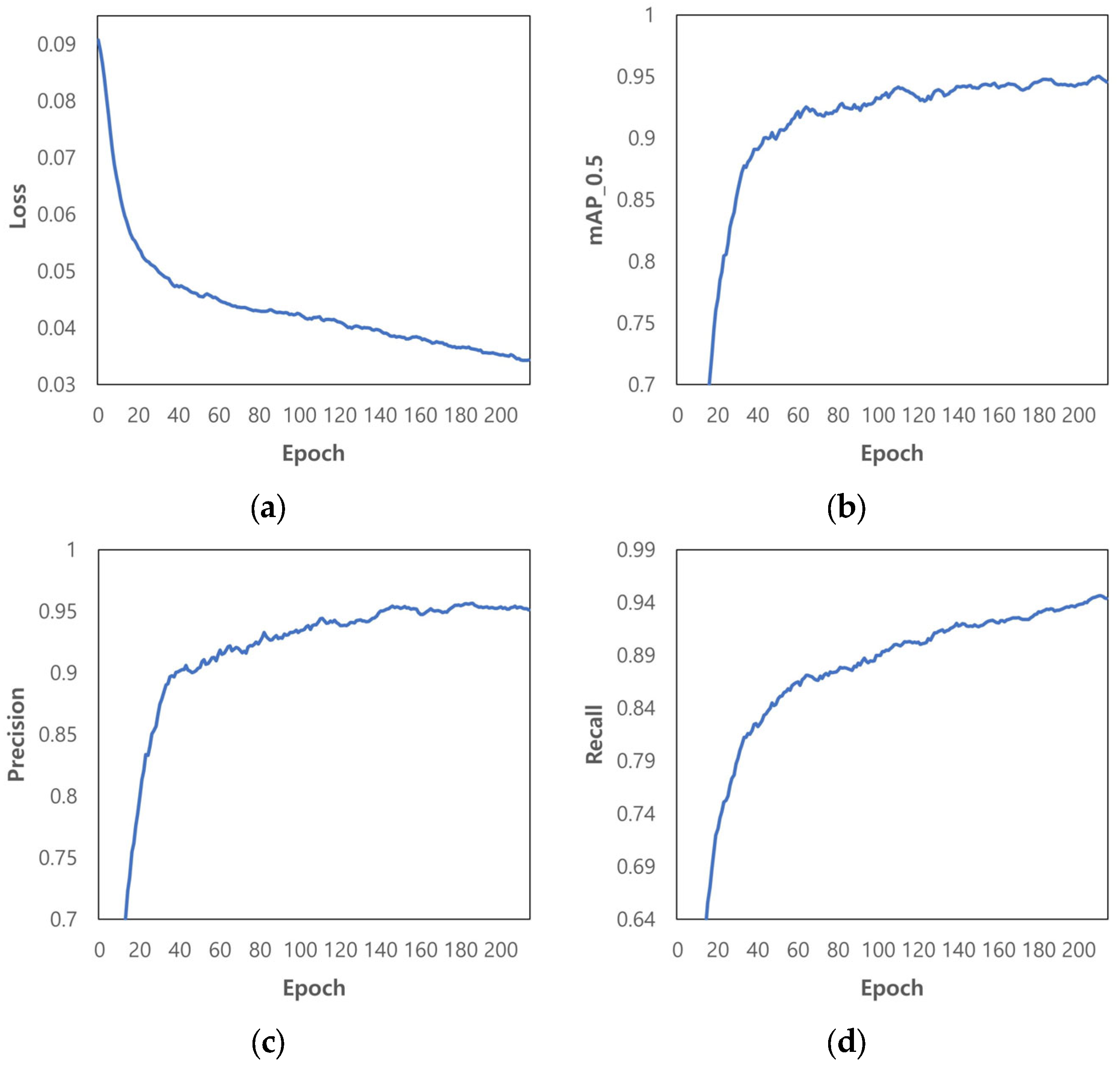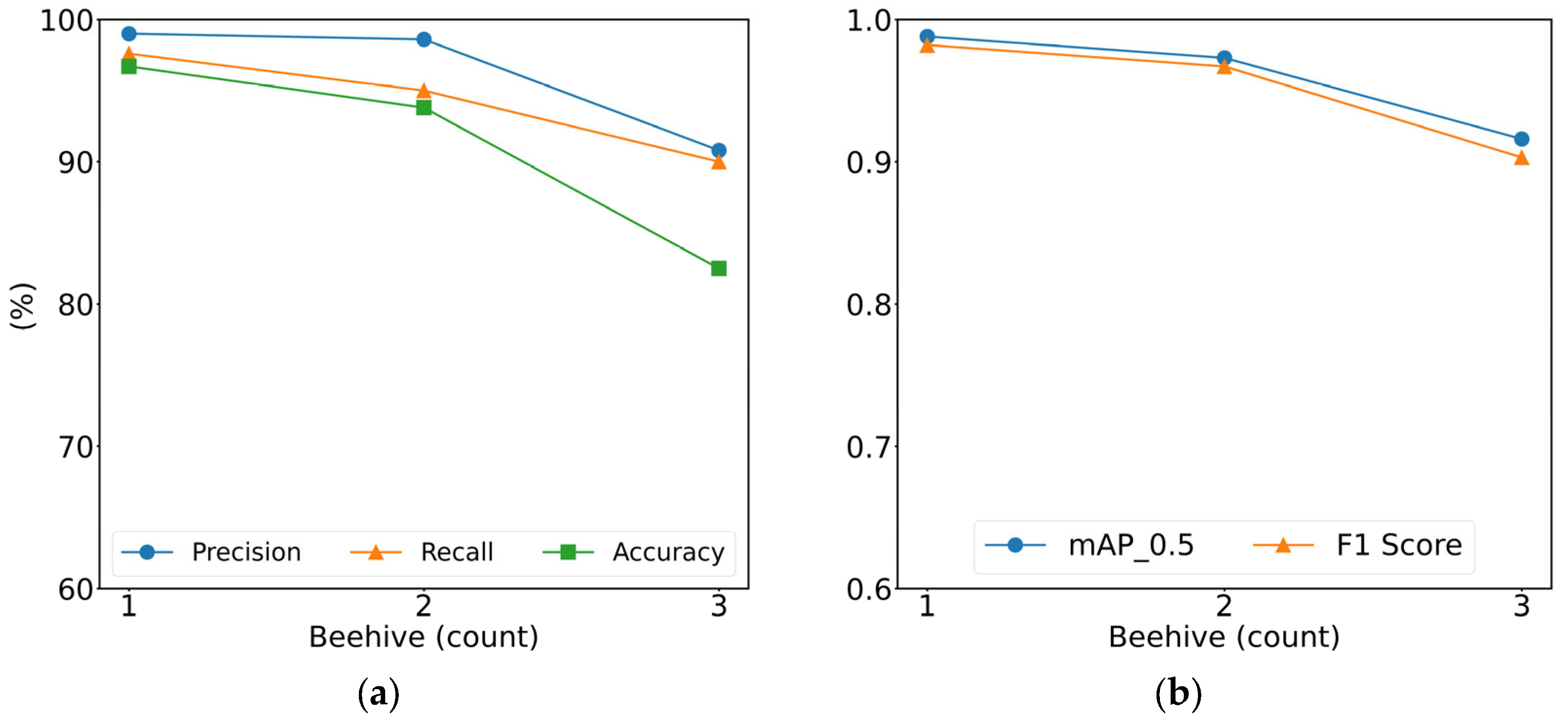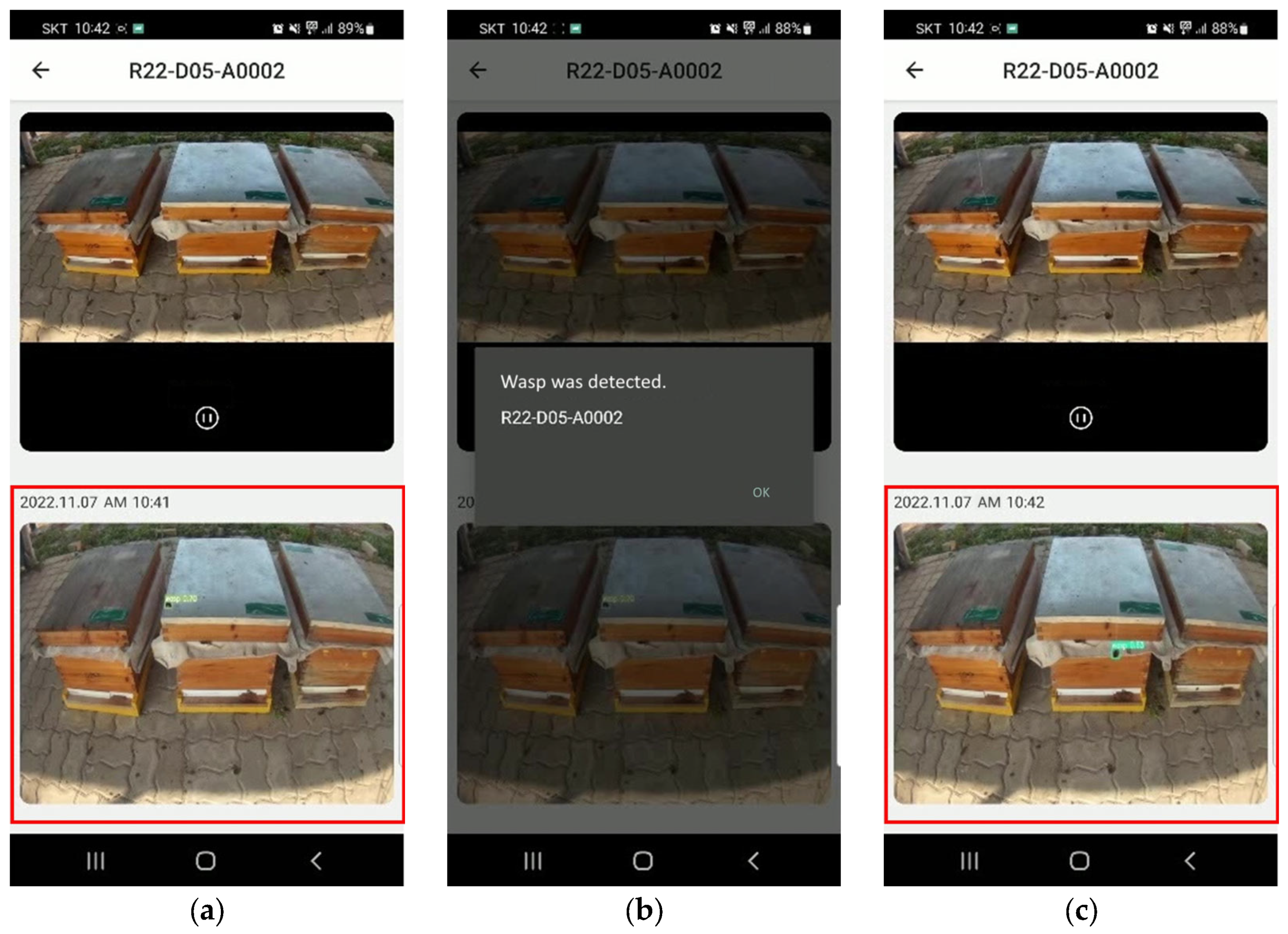Deep Learning-Based Portable Image Analysis System for Real-Time Detection of Vespa velutina
Abstract
:1. Introduction
2. Materials and Methods
2.1. System Configuration and Operation Process
2.2. Image Data Acquisition for the Training of YOLOv5s
2.3. Deep Learning Model
2.4. Performance Evaluation of YOLOv5s
2.5. Field Testing
3. Results
3.1. Outcome of Training of YOLOv5s
3.2. Performance Evaluation of YOLOv5s Based on Detection Range
3.3. Field Testing
4. Discussion
5. Conclusions
Author Contributions
Funding
Institutional Review Board Statement
Informed Consent Statement
Data Availability Statement
Conflicts of Interest
References
- Kay, A.D.; Bruning, A.J.; van Alst, A.; Abrahamson, T.T.; Hughes, W.O.; Kaspari, M. A carbohydrate-rich diet increases social immunity in ants. Proc. R. Soc. B Biol. Sci. 2014, 281, 20132374. [Google Scholar] [CrossRef] [PubMed] [Green Version]
- Klein, A.M.; Vaissière, B.E.; Cane, J.H.; Steffan-Dewenter, I.; Cunningham, S.A.; Kremen, C.; Tscharntke, T. Importance of pollinators in changing landscapes for world crops. Proc. R. Soc. B Biol. Sci. 2006, 274, 303–313. [Google Scholar] [CrossRef] [Green Version]
- Vanbergen, A.J.; Initiative, T.I.P. Threats to an ecosystem service: Pressures on pollinators. Front. Ecol. Environ. 2013, 11, 251–259. [Google Scholar] [CrossRef] [PubMed] [Green Version]
- Jung, C.E.; Kang, M.S.; Kim, D.W.; Lee, H.S. Vespid wasps (Hymenoptera) occurring around apiaries in Andong, Korea—I. Taxonomy and life history. Korean J. Apic. 2007, 22, 53–62. [Google Scholar]
- Kim, J.K.; Choi, M.; Moon, T.Y. Occurrence of Vespa velutina Lepeletier from Korea, and a revised key for Korean Vespa species (Hymenoptera: Vespidae). Entomol. Res. 2006, 36, 112–115. [Google Scholar] [CrossRef]
- Otis, G.W.; Benjamin, A. Invasion potential of hornets (Hymenoptera: Vespidae: Vespa spp.). Front. Insect Sci. 2023, 3, 1145158. [Google Scholar] [CrossRef]
- Kishi, S.; Goka, K. Review of the invasive yellow-legged hornet, Vespa velutina nigrithorax (Hymenoptera: Vespidae), in Japan and its possible chemical control. Appl. Entomol. Zool. 2017, 52, 361–368. [Google Scholar] [CrossRef]
- Choi, M.B.; Kim, T.G.; Kwon, O. Recent Trends in Wasp Nest Removal and Hymenoptera Stings in South Korea. J. Med. Entomol. 2019, 56, 254–260. [Google Scholar] [CrossRef]
- Kwon, O.; Choi, M.B. Interspecific hierarchies from aggressiveness and body size among the invasive alien hornet, Vespa velutina nigrithorax, and five native hornets in South Korea. PLoS ONE 2020, 15, e0226934. [Google Scholar] [CrossRef]
- Choi, Y.S. Anti-Damage Techniques by Vespa velutina, National Institute of Agricultural Sciences, Farming Utilization Information Interview. Available online: http://m.rda.go.kr/mobile/img/video/pdf/bee_151202.pdf (accessed on 2 December 2015).
- Choi, Y.S.; Lee, M.L.; Lee, M.Y.; Kim, H.K.; Yoon, M.Y.; Kang, A.R. Trapping of Vespa velutina nigrithorax Buysson (Hymenoptera: Vespidae) queen near apiaries honeybee comb extract in south region of Korea. Korean J. Apic. 2015, 30, 281–285. [Google Scholar] [CrossRef]
- Jung, C.; Kim, D.; Lee, H.S.; Baek, H. Some biological characteristics of a new honeybee pest, Vespa velutina nigrithorax Buysson 1905 (Hymenoptera: Vespidae). Korean J. Apic. 2008, 24, 61–65. [Google Scholar]
- Chang, Y.D.; Lee, M.Y.; Youn, Y.N. Visiting pattern and control of giant hornet, Vespa mandarinia (Hymenoptera: Vespoidea). Apiary. Korean J Apic. 1994, 9, 178–180. [Google Scholar]
- Rome, Q.; Perrard, A.; Muller, F.; Villemant, C. Monitoring and control modalities of a honeybee predator, the yellow-legged hornet Vespa velutina nigrithorax (Hymenoptera: Vespidae). Aliens 2011, 31, 7–15. [Google Scholar]
- Kang, E.J.; Lee, M.L.; Lee, M.Y.; Kim, H.K.; Choi, Y.S. Attractive effect using honeybee extraction against Vespa velutina nigrithorax Buysson (Hymenoptera: Vespidae) queen. Korean J. Apic. 2016, 31, 195–199. [Google Scholar] [CrossRef]
- Ko, K.E.; Shim, K.B. Trend of object recognition and detection technology using deep learning. J. Control Robot. Syst. 2017, 23, 17–24. [Google Scholar]
- Bay, H.; Tuytelaars, T.; Van Gool, L. Surf: Speeded up robust features. Lect. Notes Comput. Sci. 2006, 3951, 404–417. [Google Scholar] [CrossRef]
- Lowe, D.G. Object recognition from local scale-invariant features. In Proceedings of the Seventh IEEE International Conference on Computer Vision, Kerkyra, Greece, 20–27 September 1999; Volume 2, pp. 1150–1157. [Google Scholar] [CrossRef]
- Lee, Y.H.; Kim, Y. Comparison of CNN and YOLO for Object Detection. J. Semicond. Disp. Technol. 2020, 19, 85–92. [Google Scholar]
- Krizhevsky, A.; Sutskever, I.; Hinton, G.E. Imagenet classification with deep convolutional neural networks. Commun. ACM 2017, 60, 84–90. [Google Scholar] [CrossRef] [Green Version]
- Szegedy, C.; Liu, W.; Jia, Y.; Sermanet, P.; Reed, S.; Anguelov, D.; Erhan, D.; Vanhoucke, V.; Rabinovich, A. Going deeper with convolutions. In Proceedings of the 2015 IEEE Conference on Computer Vision and Pattern Recognition Workshops (CVPRW), Boston, MA, USA, 7–12 June 2015; pp. 1–9. [Google Scholar] [CrossRef]
- Redmon, J.; Divvala, S.; Girshick, R.; Farhadi, A. You only look once: Unified, real-time object detection. In Proceedings of the 2016 IEEE Conference on Computer Vision and Pattern Recognition (CVPR), Las Vegas, NV, USA, 27–30 June 2016; pp. 779–788. [Google Scholar] [CrossRef]
- Redmon, J.; Farhadi, A. YOLO9000: Better, faster, stronger. In Proceedings of the 2017 IEEE Conference on Computer Vision and Pattern Recognition (CVPR), Honolulu, HI, USA, 21–26 July 2017; pp. 7263–7271. [Google Scholar] [CrossRef]
- Redmon, J.; Farhadi, A. Yolov3: An incremental improvement. arXiv 2018. [Google Scholar] [CrossRef]
- Bochkovskiy, A.; Wang, C.Y.; Liao, H.Y.M. Yolov4: Optimal speed and accuracy of object detection. arXiv 2020. [Google Scholar] [CrossRef]
- Shi, S.; Wang, Q.; Xu, P.; Chu, X. Benchmarking state-of-the-art deep learning software tools. In Proceedings of the 7th International Conference on Cloud Computing and Big Data (CCBD), Macau, China, 16–18 November 2016; pp. 99–104. [Google Scholar] [CrossRef] [Green Version]
- Liu, W.; Anguelov, D.; Erhan, D.; Szegedy, C.; Reed, S.; Fu, C.Y.; Berg, A.C. SSD: Single shot multibox detector. In Proceedings of the 14th European Conference on Computer Vision (ECCV), Amsterdam, The Netherlands, 11–14 October 2016; Springer International Publishing: Amsterdam, The Netherlands, 2016; pp. 21–37. [Google Scholar] [CrossRef] [Green Version]
- Girshick, R.; Donahue, J.; Darrell, T.; Malik, J. Rich feature hierarchies for accurate object detection and semantic segmentation. In Proceedings of the 2014 IEEE Conference on Computer Vision and Pattern Recognition (CVPR 2014), Columbus, OH, USA, 23–28 June 2014; pp. 580–587. [Google Scholar] [CrossRef] [Green Version]
- Girshick, R. Fast R-CNN. In Proceedings of the 2015 IEEE International Conference on Computer Vision (ICCV 2015), Santiago, Chile, 7–13 December 2015; pp. 1440–1448. [Google Scholar] [CrossRef]
- Ren, S.; He, K.; Girshick, R.; Sun, J. Faster R-CNN: Towards real-time object detection with region proposal networks. In Proceedings of the Advances in Neural Information Processing Systems 28: Annual Conference on Neural Information Processing Systems 2015, Montreal, QC, Canada, 7–12 December 2015. [Google Scholar] [CrossRef]
- Iyer, R.; Ringe, P.S.; Bhensdadiya, K.P. Comparison of YOLOv3, YOLOv5s and MobileNet-SSD V2 for real-time mask detection. Int. J. Res. Eng. Technol. 2021, 8, 1156–1160. [Google Scholar]
- Herrera, C.; Williams, M.; Encarnação, J.; Roura-Pascual, N.; Faulhaber, B.; Jurado-Rivera, J.A.; Leza, M. Automated detection of the yellow-legged hornet (Vespa velutina) using an optical sensor with machine learning. Pest. Manag. Sci. 2023, 79, 1225–1233. [Google Scholar] [CrossRef] [PubMed]
- Liu, Y.; Guo, J.; Dong, J.; Jiang, L.; Ouyang, H. Priority prediction of Asian Hornet sighting report using machine learning methods. In Proceedings of the 2021 IEEE International Conference on Software Engineering and Artificial Intelligence (SEAI), Xiamen, China, 11–13 June 2021; pp. 7–11. [Google Scholar]
- Jung, C.E. Initial Stage Risk Assessment of an Invasive Hornet, Vespa velutina nigrithorax Buysson (Hymenoptera: Vespidae) in Korea. J. Apic. 2012, 27, 95–104. [Google Scholar]









| Beehive (Count) | Distance | TP * | FP * | FN * | TN * | Accuracy * | Precision * | Recall * | F1 Score | mAP_0.5 |
|---|---|---|---|---|---|---|---|---|---|---|
| 1 | 40 cm | 1017 | 10 | 24 | 0 | 96.7% | 99.0% | 97.6% | 0.982 | 0.988 |
| 2 | 55 cm | 288 | 4 | 15 | 0 | 93.8% | 98.6% | 95.0% | 0.967 | 0.973 |
| 3 | 90 cm | 189 | 19 | 21 | 0 | 82.5% | 90.8% | 90.0% | 0.903 | 0.916 |
| Appearance Time | Detected | Appearance Time | Detected | Appearance Time | Detected |
|---|---|---|---|---|---|
| 1.2 | O | 1.6 | O | 1.6 | X |
| 1.7 | O | 2.0 | X | 2.0 | O |
| 2.1 | X | 2.2 | X | 2.3 | O |
| 2.4 | O | 2.5 | O | 2.5 | O |
| 2.9 | X | 3.0 | O | 3.0 | O |
| 3.1 | O | 3.2 | O | 3.5 | O |
| 3.5 | O | 3.7 | O | 4.0 | O |
| 4.1 | O | 4.5 | O | 5.0 | O |
| 5.0 | O | 5.1 | O | 5.6 | O |
| 6.7 | O | 7.0 | O | 9.3 | O |
Disclaimer/Publisher’s Note: The statements, opinions and data contained in all publications are solely those of the individual author(s) and contributor(s) and not of MDPI and/or the editor(s). MDPI and/or the editor(s) disclaim responsibility for any injury to people or property resulting from any ideas, methods, instructions or products referred to in the content. |
© 2023 by the authors. Licensee MDPI, Basel, Switzerland. This article is an open access article distributed under the terms and conditions of the Creative Commons Attribution (CC BY) license (https://creativecommons.org/licenses/by/4.0/).
Share and Cite
Jeon, M.-S.; Jeong, Y.; Lee, J.; Yu, S.-H.; Kim, S.-b.; Kim, D.; Kim, K.-C.; Lee, S.; Lee, C.-W.; Choi, I. Deep Learning-Based Portable Image Analysis System for Real-Time Detection of Vespa velutina. Appl. Sci. 2023, 13, 7414. https://doi.org/10.3390/app13137414
Jeon M-S, Jeong Y, Lee J, Yu S-H, Kim S-b, Kim D, Kim K-C, Lee S, Lee C-W, Choi I. Deep Learning-Based Portable Image Analysis System for Real-Time Detection of Vespa velutina. Applied Sciences. 2023; 13(13):7414. https://doi.org/10.3390/app13137414
Chicago/Turabian StyleJeon, Moon-Seok, Yuseok Jeong, Jaesu Lee, Seung-Hwa Yu, Su-bae Kim, Dongwon Kim, Kyoung-Chul Kim, Siyoung Lee, Chang-Woo Lee, and Inchan Choi. 2023. "Deep Learning-Based Portable Image Analysis System for Real-Time Detection of Vespa velutina" Applied Sciences 13, no. 13: 7414. https://doi.org/10.3390/app13137414
APA StyleJeon, M.-S., Jeong, Y., Lee, J., Yu, S.-H., Kim, S.-b., Kim, D., Kim, K.-C., Lee, S., Lee, C.-W., & Choi, I. (2023). Deep Learning-Based Portable Image Analysis System for Real-Time Detection of Vespa velutina. Applied Sciences, 13(13), 7414. https://doi.org/10.3390/app13137414







